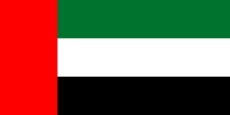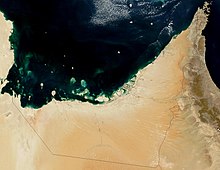
The United Arab Emirates is a country in the eastern part of the Arabian Peninsula located on the southeastern coast of the Persian Gulf and the northwestern coast of the Gulf of Oman. The UAE consists of seven emirates and was founded on 2 December 1971 as a federation, after UK armed forces left the region. Six of the seven emirates declared their union on 2 December 1971. The seventh, Ras al Khaimah, joined the federation on 10 February 1972. The seven sheikdoms were formerly known as the Trucial States, in reference to the truce treaties established with the British in the 19th century.
This article covers the various forms of transport in the United Arab Emirates (UAE), by road, rail, air, water, etc.

The Emirate of Umm Al Quwain is one of the seven constituent emirates of the United Arab Emirates, located in the north of the country. It is the second smallest and least populous emirate in the UAE and borders the Persian Gulf. Umm Al Quwain lies between Ras Al Khaimah and Sharjah/Ajman on the west coast, with a location along the vital trade route between the Middle East and India. It has a coastline stretching to 24 km.

The national flag of the United Arab Emirates contains the Pan-Arab colors red, green, white, and black. It was designed in 1971 by Abdullah Mohammed Al Maainah, who was 19 years old at that time, and was adopted on 2 December 1971. The main theme of the flag's four colors is the unity of Arab nations. In 2008, a minor change was made to the emblem.
Sheikh Sultan bin Saqr Al Qasimi (1781–1866) was the Sheikh of the Qawasim and ruled the towns of Sharjah, Ras Al Khaimah, Jazirah Al Hamra and Rams; all within the then Trucial States and now part of the United Arab Emirates. Briefly a dependent of the first Saudi Kingdom, his rule over Ras Al Khaimah ran from 1803–1809, when he was deposed by order of the Saudi Amir and restored in 1820, going on to rule until his death in 1866 at the age of 85. He was Ruler of Sharjah from 1814–1866, with a brief disruption to that rule in 1840 by his elder son Saqr. He was a signatory to various treaties with the British, starting with the General Maritime Treaty of 1820 and culminating in the Perpetual Maritime Truce of 1853.

The emblem of the United Arab Emirates was officially adopted on 9 December 1973 ; it was later modified in 2008. It is similar to the coats of arms and emblems of other Arab states.
The Constitution of the United Arab Emirates provides a legal and political framework for the operation of the United Arab Emirates (UAE) as a federation of seven emirates. The Constitution came into effect on 2 December 1971 and was permanently accepted in July 1996. Authored by Adi Bitar, a forming judge and legal advisor, the Constitution is written in 10 parts and has 152 Articles. The United Arab Emirates celebrates the formation of the Union as National Day.
Masfout is a village that forms part of the eponymous exclave of Masfout in Ajman, one of the seven emirates forming the United Arab Emirates. It is surrounded by Ras Al Khaimah, the Dubai exclave of Hatta and Oman. It is only accessible from Ajman itself by crossing territories of Sharjah, Ras Al Khaimah, and Oman.
The General Maritime Treaty of 1820 was initially signed between the rulers of Abu Dhabi, Sharjah, Ajman, Umm Al Quwain, Ras Al Khaimah and Great Britain in January 1820, with the nearby island state of Bahrain acceding to the treaty in the following February. Its full title was the "General Treaty for the Cessation of Plunder and Piracy by Land and Sea, Dated February 5, 1820".

The Trucial States, also known as the Trucial Coast, the Trucial Sheikhdoms, Trucial Arabia or Trucial Oman, was the name the British government gave to a group of tribal confederations to the south of the Persian Gulf whose leaders had signed protective treaties, or truces, with the United Kingdom between 1820 and 1892.

This is a survey of the postage stamps and postal history of the United Arab Emirates (UAE).

EmiratiArabic refers to a group of Arabic dialectal varieties spoken by the Emiratis native to the United Arabic Emirates that share core characteristics with specific phonological, lexical, and morphosyntactic features and a certain degree of intra-dialectal variation, which is mostly geographically defined. It incorporates grammatical properties of smaller varieties within the UAE, generally of tribal nature, which can be roughly divided into a couple of broader sub-varieties: the first spoken in the Northern Emirates of Dubai, Sharjah, Ajman, Umm al-Quwain, and the western part of Ras al-Khaimah; the second in the eastern part of the country, mainly in Fujeirah, Dibba, Khor Fakkan, Hatta, Kalba, and the eastern part of Ras al-Khaimah; the third in Abu Dhabi including the oasis city of Al Ain, the dialect is also seen in the Omani region of Al-Buraimi; and the fourth is the Shihhi dialect spoken in the emirate of Ras Al Khaimah which is also spoken in the Omani exclave of Musandam.
Sheikh Ahmad bin Abdullah Al Mualla was the Ruler of Umm Al Quwain from 1873–1904. He led Umm Al Quwain through a turbulent period in the Trucial Coast's history, with conflicts against neighbouring emirates and almost constantly shifting alliances. On two occasions these conflicts led to him being found to breach the terms of the 1853 Perpetual Maritime Truce with the British. This notwithstanding, he was a signatory to the 1892 Exclusive Agreement, which bound the Trucial Sheikhs and the British together in a protectorate.
Sheikh Ali bin Abdullah Al Mualla was Ruler of Umm Al Quwain from 1853–1873, one of the Trucial States which today form the United Arab Emirates (UAE).
The Perpetual Maritime Truce of 1853 was a treaty signed between the British and the Rulers of the Sheikhdoms of the Lower Gulf, later to become known as the Trucial States and today known as the United Arab Emirates. The treaty followed the effective subjugation of the Qawasim maritime federation and other coastal settlements of the Lower Gulf by British forces following the Persian Gulf campaign of 1819, a punitive expedition mounted from Bombay which sailed against Ras Al Khaimah, and which resulted in the signing of the General Maritime Treaty of 1820.
The following charts below are the family trees of the rulers of the seven emirates of the United Arab Emirates from the 18th century to present day. The House of Nahyan rules Abu Dhabi, the House of Maktoum rules Dubai, the House of Qasimi rules Sharjah and Ras Al Khaimah, the House of Sharqi rules Fujairah, the House of Mualla rules Umm Al Quwain, and the House of Nuaimi rules Ajman. The ruler of Abu Dhabi generally holds the presidency of the UAE and the ruler of Dubai holds the vice presidency and premiership.












